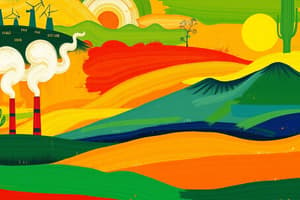Podcast
Questions and Answers
Which greenhouse gases are produced by agriculture?
Which greenhouse gases are produced by agriculture?
- Carbon Dioxide, Methane, Nitrous Oxide (correct)
- Ozone, Carbon Dioxide, Nitrous Oxide
- Methane, Nitrogen, Oxygen
- Hydrogen, Carbon Dioxide, Sulfur Dioxide
Eutrophication can negatively impact water quality due to the run-off of nitrates and phosphates.
Eutrophication can negatively impact water quality due to the run-off of nitrates and phosphates.
True (A)
What agricultural practice is becoming more popular due to awareness of food production?
What agricultural practice is becoming more popular due to awareness of food production?
Organic farming
The practice of using a buffer zone of _____ meters from hedgerows and water courses can reduce the effects of agricultural runoff.
The practice of using a buffer zone of _____ meters from hedgerows and water courses can reduce the effects of agricultural runoff.
Match the agricultural practices with their effects on biodiversity:
Match the agricultural practices with their effects on biodiversity:
Flashcards are hidden until you start studying
Study Notes
Agriculture and Greenhouse Gases
- Agriculture is the largest contributor to greenhouse gas emissions.
- This is due to the lack of heavy industry in the agricultural sector.
- Agriculture contributes to greenhouse gases in the form of carbon dioxide, methane, and nitrous oxide.
Water Quality and Eutrophication
- Agricultural practices can negatively impact water quality through a process called eutrophication.
- Run-off from fertilizers containing nitrates and phosphates can cause excessive algae growth, leading to algal blooms.
- Algal blooms block sunlight, inhibiting photosynthesis and causing fish deaths.
- Implementing a 5-meter buffer zone between fertilizer application areas and watercourses can reduce the impact of eutrophication by half.
- Farmers should collect and prevent waste from dairy parlours, cattle yards, and pit washings from entering waterways.
Biodiversity and Agricultural Practices
- Land drainage, pollution, and improper grazing practices are significant threats to biodiversity.
- The shift from haymaking to silage production negatively impacts bird populations.
- Corncrakes, which traditionally nest in tall grasses, suffer habitat loss due to silage making.
- Hedgerows, which provide natural barriers and shelter for livestock, are crucial for biodiversity.
- Promoting hedgerow growth enhances habitat for various species.
Organic Farming and Sustainability
- Organic farming is gaining popularity as consumers become more conscious of food production methods.
- Organic farming relies on biological controls, crop rotation, and eliminates the use of chemical fertilizers and pesticides.
- Organic practices contribute to less pollution and healthier habitats compared to conventional farming.
Studying That Suits You
Use AI to generate personalized quizzes and flashcards to suit your learning preferences.




